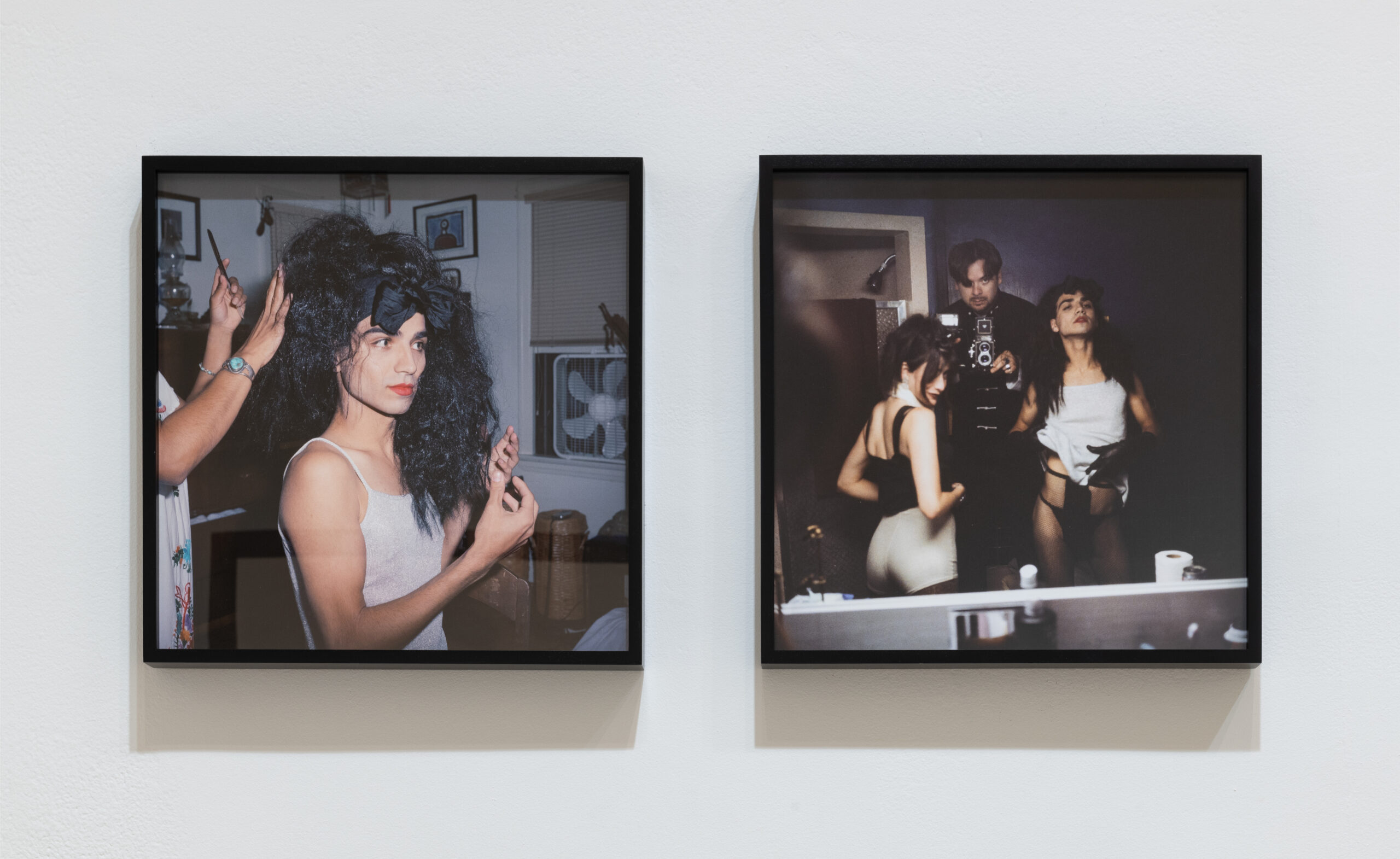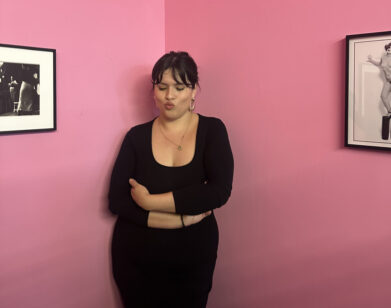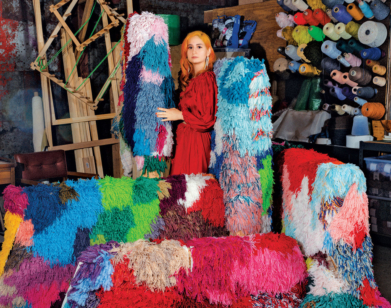RAZA
Reynaldo Rivera and Willy Chavarria on Cholas, Crazy Exes, and Gang Rites
“I’ve never even called myself a photographer. I just do what I do,” said Reynaldo Rivera when he reunited with his old friend and fashion designer Willy Chavarria to play dress-up before his new exhibition. Fistful of Love/También la belleza is Rivera’s first solo show, long overdue, currently on view at MoMA PS1. An exclusive deep-dive into the artist and nightlife documentarian’s black-and-white photo and camcorder archive, it captures the old-school cinematic glamour that Rivera has been surrounded by since the ’80s, when he photographed punk club kids, drag queens, and celebrities alike. But Rivera and Chavarria’s connection goes back even further—after both being raised in ’70s SoCal by Mexican agricultural worker parents, they met through a mutual friend in L.A. but lost touch when Chavarria moved to New York and pursued fashion—a city Rivera hasn’t visited in 24 years, until their reunion. And for both artists, context is everything, as they reinterpret the cultures they grew up with for others to understand Chicano cultural contributions. “We need to write the story so that we are not a footnote,” Rivera said, as they caught up on everything from cult film to gang initiations and manifesting commercial success.
———
REYNALDO RIVERA: I really like that shirt. I want that shirt. I want glitter. I’m a fucking old queen, I deserve that.
WILLY CHAVARRIA: I like that shoe.
RIVERA: With what I’m wearing? I mean, shit, I’m wearing you.
CHAVARRIA: It looks cool. I’ll take a photo of you, and you take a photo of me.
RIVERA: That’s a good idea. I’m ready for my closeup.
CHAVARRIA: I’m gonna put you between these palms like the Virgin Mary. Don’t smile at all. Not even with your eyes. [Camera clicks] Think of nothing but pain.
RIVERA: Look, I live in pain.
CHAVARRIA: That’s great. You know what photo has stuck with me? The death scene, the murder scene. That photo is so intense.
RIVERA: That was shot with my first camera when I went to Mexico City with my dad. It’s the remnants of my grandfather. He was defending the lady that was getting beaten by her husband. Tilt back your face because this is the only light we have. [Camera clicks] You’re very thoughtful. I don’t know what the fuck you’re thinking, but whatever it is looks very deep.
CHAVARRIA: I’m thinking of San Francisco versus L.A. in the ’90s.
RIVERA: Well, I feel like all these people escaped San Francisco in the ’90s, people that survived the AIDS programs, and a lot of them moved to L.A. You were there for school, no?
CHAVARRIA: I was trying to go to school, but it was really hard to afford.
RIVERA: But mija, didn’t you get all the grants to go to school?
CHAVARRIA: I got some, but it was still hard. So I basically just got into nightlife.

“Bianco, Silver Lake.” 1994/2024, digital inkjet print; “Bianco, Reynaldo Rivera, Amy Darca, Silver Lake.” 1994/2024, digital inkjet print. Photo by Adam Reich.
RIVERA: Is that how you met Javier?
CHAVARRIA: No, Javier and I grew up in the San Joaquin Valley.
RIVERA: You know, I photographed his whole family a long time ago. We stayed up in some hotel. It reminded me of Ken Park. I wanted to choke myself in the toilet like Kenny did at the end.
CHAVARRIA: You know that’s based on Visalia[, California]?
RIVERA: I know, man. That’s why I’m saying it. I wanted to hang myself in the toilet and jerk off. I actually saw that actor at the Municipal Art Gallery in Los Angeles. I wanted him to sign something for me. I was like, “I should have brought a porn or something.”
CHAVARRIA: When’s the last time you went to New York?
RIVERA: 2000. Twenty-four years ago, and before that it was ’85.
CHAVARIA : How does it feel?
RIVERA: You know, I think I’m dead inside. I drove across the country [for this show], but I don’t know. It’s just another city.
CHAVARRIA: You drove?
RIVERA: Yeah. I don’t like flying. I have agoraphobia.
CHAVARRIA: Where did you stay along the way?
RIVERA: All these funky ass places.
CHAVARRIA: Who did you drive with?
RIVERA: With two friends and my man. We rented a car, just some big old van.
CHAVARRIA: Are you going to go slow on the way back?
RIVERA: I mean, the idea was to stop in thrift stores. I thought, “Maybe I’ll find something cool on the way,” but no, I didn’t. Just shitty hotels. I will say, I don’t mean to insult anybody, but going through those really white states really freaked me out.
CHAVARRIA: Which ones did you go through?
RIVERA: Utah always freaks me out. I can’t help it, it’s part of my survival mechanism. If I see Latinos somewhere, or even Black folk, I feel like, “Okay, it’s not that fucked up around here.” It’s like in the old days when you went to a club and you ran into someone Latino like yourself. It was nice to see your own folk, then you don’t feel so alienated.
CHAVARRIA: Yeah. In Texas, there’s this town I used to go to—
RIVERA: Did you live in Texas?
CHAVARRIA: No. There was a factory I came across there that had potential, but I couldn’t really figure out how to get it going without money. But I would go to this little town and it was all white, and I would go to the diner and it was like a movie. The forks would drop.
RIVERA: Right.
CHAVARRIA: Everyone would look.
RIVERA: That was the experience of going to a cafe in Lincoln, Nebraska. It’s good and fun, and then we all walk in and boom. It’s just instant silence. It was like a horror movie. It definitely didn’t help the digestion.
CHAVARRIA: It’s scary as fuck.
RIVERA: When did you start doing la ropa?
CHAVARRIA: I don’t even know. I think it started as a child.
RIVERA: I think most of us homos are into clothes. But some of us just like the clothes, and you end up making the stuff. I think there was a moment where I wanted to make shit just because I wanted to wear something specific, but I don’t think I ever wanted to design clothes for other folk.
CHAVARRIA: I just wanted to have a giant brand. Before people were talking brand. I remember always writing my name as a label, like my signature, and then putting a box around it and thinking, “I’m going to have a store.” Do you remember GEMCO?
RIVERA: Yes.
CHAVARRIA: I wanted to have a store like GEMCO. And San Francisco was the space where I discovered people dressing up to go out and becoming these superheroes that you weren’t during the day, in the club scene.
RIVERA: I mean, that’s what superheroes are about anyway. They’re hiding their identity during the day.
CHAVARRIA: Right. So I was like, I love this. Not necessarily even the clothes themselves, but what they do to the person who’s wearing it. I started working my ass off in the stores until I learned how to do it myself, basically.
RIVERA: But I think it’s interesting that you visualized this from early on, because we were talking about all this new-agey shit back at the dinner.
CHAVARRIA: Manifestations.
RIVERA: You manifested it from the get-go, label and all.
CHAVARRIA: Well, I think you manifested this when you were taking pictures of your grandfather’s death.
RIVERA: But it’s not the same, because I was documenting stuff out of a need to not be alone. I moved around a lot with my dad, and so photography was the only constant thing. I printed this shit and I was able to carry it all with me wherever I went. That’s really what it meant to me for the first 10 years.
CHAVARRIA: Did you see it as art or as documentation?
RIVERA: Well, I didn’t really see it. It was just something I did, almost like therapy. I wasn’t thinking about any of those lofty things. I think I just can’t let go of shit, and photography captures things forever. It’s the ultimate shitty affair. I mean, until you set your shit on fire like my ex did. But even then, I still have some of that stuff. We’re working on a second book and I wanted to use this note one of my exes left me. After he burned my negatives, he ripped a photo and left a note saying, “Who would’ve known that by loving you, I was in bed with a devil?” He died in 2000. Stevie, he was friends with David [Olivares] back in the old days. That bitch was crazy. When I see all the references of all the people we grew up with, it’s all there. The baggy pants with the sequins. I have these friends up in Sacramento that I left back in the early ’80s, so they never saw my transition. So they still call me by my gang name when I go visit them. I haven’t had the heart to tell them.
CHAVARRIA: What’s your gang name?
RIVERA: I’m not going to tell you.
CHAVARRIA: Spooky.
RIVERA: No. [Laughs] But some of the old records that I kept have it written on them, because they’re some of the few things that I’ve managed to hold on to this long. I still have this record my sister bought in ’79. That was the transition period between chola and new wavey, punk rocker girl. It was quite a shift. It was severe, there was no cross-politics. I remember one time being in the RTD going down Colorado Boulevard and these fucking old veteranos walked onto the bus. I was sitting there, blonde hair with the fishhooks in the ears and shit, and they fucking eyeballed me. I know they knew who I was.
CHAVARRIA: Did they recognize you?
RIVERA: Yeah. I was just like, “Okay, I’m going to act like I don’t know them.” Luckily nothing happened, because that Blood In Blood Out shit’s real. I got jumped in and if you’re going to go out, you’re going to get jumped out. But that never happened. I just left. I was afraid because some of this goes on forever. They’re like whales, they don’t forget nothing. Luckily most of the people in that scene are in prison now.
CHAVARRIA: Or dead.
RIVERA: Yeah. But the scary ones are in prison. And it ain’t just in the movie. I’m sure you saw Blood In Blood Out.
CHAVARRIA: Of course. That’s a cult movie.
RIVERA: Wait, do you remember the first gang movie? All the razas went to go see it, Boulevard Nights.
CHAVARRIA: Oh, of course. It wasn’t even a good movie.
RIVERA: It was fucking awful. Actually, Little Puppet sent me a message on Instagram. I ran into him at Trader Joe’s.
CHAVARRIA: What the fuck?
RIVERA: I know. He stopped me like, “Oh my god, I love your book.” And then when he friended me on Instagram, I was able to see who he was. I was like, “Oh my god, you’re from Boulevard Nights.”
CHAVARRIA: That’s incredible.
RIVERA: Who would’ve thunk back in 1979 that we’d be doing this, huh? It wasn’t even an idea. I was smoking PCP hanging out with the homies.
CHAVARRIA: I didn’t even really know that any of this life existed. It was different back then because there was no internet.

“Pamela Mendez and Pablo Aguirre Lopez, Echo Park.” 1994/2024, digital inkjet print. Courtesy the artist.
RIVERA: Plus, Latino parents never tell their kids to ever get anywhere near art. They don’t take any of this shit serious. It’s like art was something white folk did.
CHAVARRIA: Yeah, completely.
RIVERA: Later I started hanging out with all these kids at Pasadena City College when my sister took a cinema class. I used to go with her and I met all the cool kids. I’ve never even called myself a photographer because I never went to school for it. I just do what I do.
CHAVARRIA: What about some of your early fashion photography?
RIVERA: My sister loved clothes. I had a camera and I had a friend that worked at a newspaper. She was the fashion editor, so she was like, “Just make up some shit and I’ll write something and put it in the newspaper.” And me and my sister did a few fashion trends that never existed in real life, but once it was in the newspaper, it was real. My sister used to sew the clothes and then I’d go take photos of her with the clothes. We did that for money. I never thought of it as anything past that.
CHAVARRIA: What were the trends?
RIVERA: The Cha Chas. There was this group of girls in East L.A., they used to call themselves Cha Chas, with the big fucked up hair. So we took that and just kinked it a little. Made it a little more edgy, more trendy. Fashion a la Mexicana was the other one. They had a show of Frida [Kahlo] at the Plaza de la Raza. Have you ever been there?
CHAVARRIA: Yeah, yeah.
RIVERA: It’s like a youth center with a little gallery on the side. That was the first time that Frida showed any paintings in L.A. I mean, I could have walked out with all that shit. There was no security.
CHAVARRIA: That’s amazing.
RIVERA: I am amazed that she became what she became. She was well known in Mexico by certain folk, people that read about art, because she was what’s-his-name’s wife. But very few people collected her, if any.
CHAVARRIA: How did she get so commercialized?
RIVERA: Madonna bought some of her paintings.
CHAVARRIA: No. She was big before that, wasn’t she?
RIVERA: I’m telling you, even in Mexico, she was Diego Rivera’s wife. Actually, there’s something I wanted to ask you about these clothes that I consider chola wear.
CHAVARRIA: Yeah.
RIVERA: How do you feel when you see other folk wearing all this stuff? You know where it comes from, and it’s cool that you’re taking this style that was so much our thing and making it visible. But in the past there’s been other folk that have taken our shit.
CHAVARRIA: Oh, yeah. Everybody has taken it and used it. Madonna too. So I think my role is to take the influences and reinterpret them as something beautiful and artistic so that it’s appreciated by everyone, especially us. So often Chicano-influenced art has to be, like, Mister Cartoon or a chola wearing a plaid shirt.
RIVERA: It’s kitschified.
CHAVARRIA: And it’s the same thing over and over on repeat. Even our own people, if they see something that’s a little bit outside of that, there’s a push.
RIVERA: Right. I don’t think Latino folk see that what they are doing is worth anything or that they are creating style or all the shit they influence in the world. I’m 59, so I’ve seen how so much super cholo stuff makes it to runways. I think it’s cool that you’re able to take our thing and put it in this different context.
CHAVARRIA: Context is everything. Like, skate culture borrowed its look entirely from Chicano culture, and they got all the credit for the baggy pants and the Dickies. But it was the white money behind skate culture that capitalized on that look and put it on billboards. That happens in so many aspects of any Black culture or Brown people’s culture where the people that don’t have the money don’t get the credit for it. I even feel like cholos influenced Chicanos overall.
RIVERA: Right, because at one time there was really only a very small group that wore this stuff. I mean, tattoos, that was strictly a raza thing. I ain’t even tripping. In the old days, who the fuck had a tattoo if they weren’t Latinos? And hardcore cholos at that? I got a tattoo on my back when I was 13, from some dude from the gang. Partly what I feel like I’m doing is taking some of this back and saying, “We’ve been there, we’ve done this,” without pointing fingers. We need to write the story so that we are not a footnote. Usually when I do research about us, I always have to read everyone else’s footnotes, because that’s the only place I would find the roles any minorities played in fashion. I was reading about Coco Chanel and how the people that did all the piping on her first outfits were Armenians in Paris in the ’30s that knew how to do that shit.
CHAVARRIA: They probably had been doing it for years.
RIVERA: But that was in the footnotes, not as part of the main story on this fucking Chanel lady. Like that book, The Revolt of the Cockroach People, we’re those cockroach people. We just keep going.










